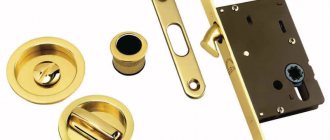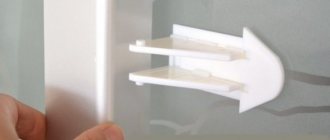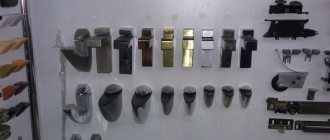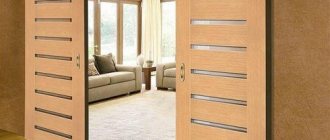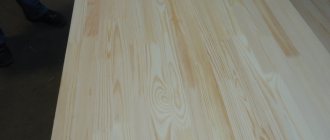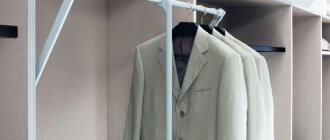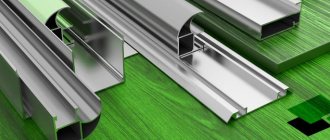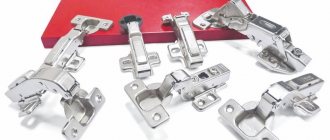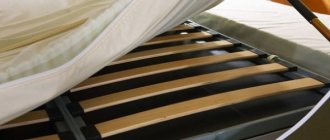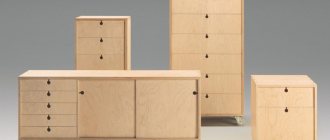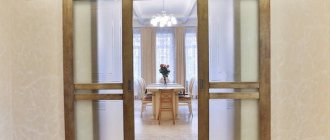The design of a furniture lock is determined by the material on which it is installed. This is explained by the fact that the lock is designed for a certain thickness of the door or drawer front and a different method of fastening (for example, you cannot screw a self-tapping screw into glass).
Castles are divided into:
- furniture locks for chipboard and wood (as a rule, designed for a thickness of 16-18 mm) When attaching furniture locks to chipboard and wood, practically no problems arise: a hole is drilled for the cylinder, and the lock body is attached on the reverse side. On the outside, the hole for the larva can be decorated with decorative overlays.
- furniture locks for glass (usually glass with a thickness of 5-6 mm is used, rarely 8 mm) Locks for glass are universal; glass of any thickness used can be secured in them. They are also suitable for metal (e.g. metal cabinets, mailboxes). Glass locks come in mortise locks (requiring glass drilling) and overhead locks. The difficulty of installing mortise locks is that not every manufacturer has the ability to drill glass well and accurately install a lock in these holes. Thus, drilling requires a special machine with drills for diamond-coated glass, drilling glass from both sides at the same time. In this case, a cooling emulsion should be supplied, which makes the process better. Such a machine costs from 5 thousand EUROS.
Therefore, rim locks are most often used for glass doors, for the installation of which it is not necessary to drill the glass. These locks have an “L-shaped bar” that fits over the glass. Screws are inserted into the holes in the bar and the lock is pressed against the glass through a plastic spacer.
Locks also vary depending on what they are for: drawers, sliding doors, or hinged doors. Locks for swing doors are divided into locks for one door and for double doors.
In addition, locks differ in the principle of operation of the mechanism: with a retractable tongue, rotary, push-button, harpoon-shaped, rack and pinion with a locking mechanism.
The designs and mechanisms of operation of locks in most manufacturing countries are very similar, so we will focus on the main models that are a priority for the Russian market.
Installing the main types of locks on furniture with your own hands
The process of installing a furniture lock yourself is not complicated. Most often, the product kit includes all the necessary components, including fastening elements for the lock, and complete instructions for installation.
The lock for wardrobes and furniture with a folding or folding opening system is installed in the same way as locks designed for swing doors. Therefore, we will consider the processes of installing locks only on swing doors.
Installation of a furniture mortise lock
Before starting installation you need to prepare:
- tools for marking (ruler or tape measure, pencil);
- drill;
- a screwdriver or screwdriver of a suitable size.
The lock is installed according to the following scheme:
- Carefully and accurately markings are made to install two lock blocks (the locking mechanism and the block for inserting the latch);
The process begins with marking
It is recommended to install the locking device at a distance of 2/3 from the floor.
- using a drill, holes are drilled for attaching the lock and inserting the locking mechanism;
We begin drilling by selecting a suitable drill bit.
- The main lock block is attached to the door leaf, and an additional one is attached to the furniture body. For this, self-tapping screws and a screwdriver are used;
- the functionality of the structure is checked. To do this, the wardrobe with a lock opens and closes several times. If necessary, the lock is adjusted.
Furniture lock installation diagram
Furniture lock cutout for doors or drawer fronts. The length of the lock cylinder (Z) must be no less than the thickness of the embedded element. The size of the lock tongue (C) should not exceed the size of the shackle (e). To install the bracket, select self-tapping screws with a small head. Adjust doors and drawers before installing the lock, set the same distances with the furniture body.
Tools for marking and inserting a lock
To mark, we use a tape measure, a measuring angle, a ruler, and an awl for marking. A caliper may also come in handy if you have one in the house. A cordless screwdriver is the most convenient tool for inserting locks and tightening screws; you can use an electric drill and hand screwdrivers. The feather drill must match the diameter of the lock cylinder (X). It is advisable, but not necessary, to initially make a path for the feather drill using a small 2-3 mm drill.
Making the markings
Decide on the installation location of the lock; the lock mechanism should not fall on the handle mounts. When closing the lock, the latch moves evenly beyond the bracket.
What should you pay attention to? How the door is positioned relative to the body.
The size for the cutout in the internal door should be as in the example E + A + 2 mm from the edge of the door, subject to minimum clearances between the door and the body. The bracket is installed deep in the body along the thickness of the door (g).
- Markings on the door
- E – staple width
- A – size from the middle of the cylinder to the latch in the retracted position
- 2 mm – for displacement
interior door
The outer door stands on an overlay, covering the ends in the furniture body. The bracket is attached to the edge of the inner panel. The edge of the door should match the edge of the outer casing.
- Calculation form A + E + F + 2mm.
- A – size from the middle of the cylinder to the edge of the latch in the retracted position
- E – staple width
- F – body panel thickness
- 2 mm – for displacement
external door
We cut into the lock
We make a mark on the front side of the door.
Use a small drill to drill a through hole. Using a feather drill, we make a small recess on the inside of the door along the through hole and drill through it with the front one. We insert the lock, apply a decorative ring and fix the lock block with self-tapping screws. Furniture lock cutout for doors or drawer fronts. The length of the lock cylinder (Z) must be no less than the thickness of the embedded element. The size of the lock tongue (C) should not exceed the size of the shackle (e). To install the bracket, select self-tapping screws with a small head. Adjust doors and drawers before installing the lock, set the same distances with the furniture body. 2018-03-11T00:04:03+04:00, Furniture Service Masters
Which cabinets can be equipped with locks?
Types of cabinets
Modern manufacturers produce cabinet and built-in cabinets equipped with protective devices against unauthorized entry.
When ordering cabinet furniture, you can immediately specify the installation of a lock
Built-in wardrobes can also be equipped with locking hardware
Cabinets can be made from:
- metal A metal cabinet with a lock is used in enterprises and offices in the form of safes and changing rooms for staff;
Such safes are usually installed in locker rooms
- Chipboard or fibreboard. Furniture cabinets for the home and wall cabinets are mainly made from this material. A wall cabinet with a lock is used in the kitchen for storing dangerous products, for example, vinegar essence;
Chipboard kitchen cabinets can be padlocked
- glass Glass cabinets are used at home to store dishes, books, etc., as well as in bars, restaurants, canteens, and shops.
Glass cabinet with key
Cabinet doors can be:
- sliding (sliding wardrobes);
- swing;
- foldable.
Each type of door has its own locking system.
Cabinet selection criteria
The choice of cabinet should be based on the following criteria:
- at its location. Glass or wooden cabinets are suitable for your home. Metal cabinets are more suitable for offices and enterprises;
- on the door opening system. Sliding wardrobes and furniture with folding doors will save space in the room;
- on reliability. If you plan to store important documents or weapons in a cabinet, then it is more advisable to use cabinets made of metal. Such a filing cabinet with a lock will keep your property safe and protect it as much as possible from fires and other disasters;
- on the type of property intended for storage. If you need to place dishes, books, photographs or make a display case in a store, cafe, etc., then it is more advisable to purchase a glass cabinet. Cabinets made of wood are more suitable for storing clothes.
Features of choosing and installing furniture locks
Installation of a furniture lock usually occurs at the factory. Most types of furniture are equipped with this function: most often these are cabinets, furniture fronts, table drawers. A lock can be useful not only to prevent anyone from getting into the contents of the drawer, but also to prevent cabinet doors from opening on their own, for example, if the furniture is not level. It is quite convenient and looks aesthetically pleasing.
What is a furniture lock? Types of products
When choosing a lock, it is important to consider the thickness of the furniture doors; The method by which the installation will be carried out also plays a significant role, since different types of locks may require insertion or do without it.
Furniture fittings and locks can have different designs and are made from various materials, lightweight and durable. After all, for furniture it is important that the device not only protects against burglary, but also looks decorative.
Cabinets with locks are no longer a rarity; they will help protect things from a thief if he breaks into the apartment, secure the doors, and protect the contents of drawers and shelves from curious small children who might eat or spoil something.
Child locks on furniture are usually simple in design; an adult can open them without difficulty, but children will not be able to cope with such a task. This will protect not only things, but also the child himself, if, for example, breakable objects are stored in the closet that could cut the child. Such locks are sometimes called postal locks. They should not be confused with small hinged ones, which are used to protect the mailbox. The types of locks are as follows:
- Mechanical: common, opens with a key.
- Electronic: - to open, you need to dial a code.
- Magnetic: requires a special key to open. It closes using a magnetic field and requires electricity to operate.
Devices and installation methods differ. The following types are distinguished:
- The most common furniture lock is the mortise lock. Often used for wardrobes and other types of furniture, it is not noticeable, does not take up space and does not interfere with the opening of doors.
- The second most popular are rim locks. Most often they are installed on glass doors, since it is not possible to embed a lock into them, but the opening of the doors will be limited. Fixation occurs using bolts; in this case, the glass will have to be drilled. Magnets are used less often, and then drilling is usually not necessary.
Purpose and features
Furniture locks belong to the group of detachable fastening fittings, which also includes door handles, clamps, latches, hooks and latches. According to the structure of the mechanism, they are divided into certain categories. The design of the device depends on the material it is made of. Due to the fact that furniture locks are designed for a certain thickness of material, where the installation takes place, their structure will differ.
Furniture locks are used on cabinet doors, drawers, wooden safes, bedside tables, wall cabinets and other parts of furniture items. To understand what the products are intended for, you should consider their features:
- Material of manufacture - furniture locks are mainly made of durable materials - steel, aluminum, metal alloys. If it is made from a less practical material, such as plastic, the feasibility of its use is reduced. The best are metal options that will reliably hide the necessary items;
- Fastening area – depending on the material where the lock will be installed, many of its characteristics change. For example, the option for installation on glass will have a thickness less than its counterpart, which is intended for furniture made of laminated chipboard. This indicator should be taken into account when choosing a device;
- Mechanism - according to the principle of operation, there are push-button, rack and pinion, rotary and retractable. Each of these types of furniture locks for cabinets is used for specific purposes;
- Type of lock - there is a mortise lock, which is built into the surface of the facade, as well as overhead options. The latter are much easier to install: you don’t need to call a specialist to attach them, because everything can be done yourself;
- Reliability – modern manufacturers of furniture fittings have taken care to ensure the reliability of locking mechanisms. Mechanical options are gradually losing popularity, they are being replaced by innovative analogues: magnetic, electronic and code options. They provide an increased level of reliability;
- Size – according to the dimensions of the cabinet or other furniture, locks can be selected according to the size.
The main purpose of locks is to ensure secure storage of documents and other valuables. Another functional purpose is to close doors that are constantly opening.
Product Features
Furniture locks are included in the basic package of many sets and are installed at the factory during the assembly process. The traditional design is a conventional locking mechanism equipped with a tongue, a key and other necessary elements. The main purpose of the part is to keep the doors tightly closed. If necessary, you can install this element on finished furniture, where the presence of locks was not originally designed.
The main feature that furniture locks have is their size. Compared to conventional designs, they are reduced several times. This allows for hidden installation and maximum hiding of locking mechanisms.
Furniture locks are used on various items, doors or drawer linings. The following designs exist:
- Button lock. Used for sliding wardrobe doors. To close it, you need to press the lock cylinder (or lock cylinder). Unlocks with a key - 2 pieces included.
- Rack and pinion. Used for fixing glass sliding sashes. This group also includes a latch version, which is installed on hinged doors in a horizontal position.
- With latch. Its design is closest to conventional locking mechanisms. Used for installation on hinged doors of cabinets or on drawer linings. Locks itself, opens with a key (2 pieces included).
- Overlay for glass sashes. There are models for single and double door cabinets.
Review of basic types of furniture fittings, selection criteria
Button lock
Rack and pinion
With latch
Invoice
Different materials are used for production:
- steel;
- aluminum;
- metal alloys;
- plastic.
The most preferred are steel devices, which are durable and reliable. Depending on the type of finish, there are gold, silver, and blackened products. The selection of a suitable model is carried out taking into account the type of design of the element and the design style of the headset. A lock in furniture should not only fulfill its direct tasks, but also provide decorative design, decorate the doors or linings of various products.
Steel
Aluminum
Metal alloys
Plastic
Varieties
There is hardly any need to talk about what rim locks, like other types of furniture locks, are used for. Everything is already very clear.
Locking mechanisms or locking furniture fittings are divided into several categories depending on certain design features, materials used, mechanisms, etc.
For some, a classic old-style round lock like Pinocchio is perfect, while others will need a modern block, supplemented with electronics.
Let's look at what furniture locks can be.
- According to the material of manufacture. In most cases, steel, aluminum or an alloy of different types of metal is used. But you can even install a plastic lock, although then its reliability and practicality will be much lower. If it is important for you to get a high-quality and durable lock with a cabinet key or to prevent children from getting into places where they shouldn’t, choose metal fittings;
- Installation location. When choosing a furniture lock of the overhead type, be sure to consider where exactly the installation will be carried out. For example, the central one for a bedside table made of chipboard, MDF or wood will be thicker. But for lining glass doors, more compact and thin models are needed;
- Mechanism. According to the mechanism, all furniture locks, including overhead locks, are divided into retractable, rotary, rack and push-button;
- Locking mechanism. Previously, only mechanical fittings were offered. Now they are being replaced by electronic, coded and magnetic solutions;
- Dimensions. Here it is worth starting purely from the furniture on which the device will be mounted.
Overlay elements fit perfectly into a drawer and are suitable for hinged doors and sashes.
The main thing is to know why exactly you need a lock. And then there will be no problems with selecting a suitable model.
Furniture locks for chipboards
Locks for chipboard and wood are designed for a thickness of 16-18 mm. When attaching furniture locks to chipboard and wood, practically no problems arise: a hole is drilled for the cylinder, and the lock body is attached on the reverse side. On the outside, the hole for the larva can be decorated with decorative overlays.
Can be called the most common on the Russian furniture market. It is suitable for both drawers and swing doors made of wood and chipboard. When you turn the key, a tongue extends from the lock body, which either enters a hole in the furniture body, trimmed with a trim strip
, or goes beyond the corner bar
.
There is a model in which the tongue does not “hide” in the lock body, but “moves” up and down.
allows the corner bar to act as a stopper. In this case, the strip is attached closer to the door. When locking the lock, it fits tightly between the tongue and the door. As a result, the door rests against the bar and does not dangle.
To secure a double-leaf swing door made of chipboard or wood, there is a lock with a twist mechanism with a double tongue
. The tongue is made in the form of two plates of different lengths, connected to each other at right angles. When you turn the key, the short tongue locks the door on which it is attached relative to the cabinet body, going behind the corner bar, while the long tongue locks the second door.
For office cabinets, which usually consist of 3 drawers, less often 4-5, there is also a solution: furniture manufacturers have a choice: put a lock on each drawer or prefer a more economical option - central locking
, locking all drawers at the same time. The lock mechanism is rotary, but it is not the tongue that rotates, but the pin. At the same time, a long bar on which the rods are located rises or lowers. When the bar is lowered, each rod goes behind the trim bar or falls into a special recess in the corresponding box, fixing it. If necessary, the length of the rods increases: a thread is cut inside into which a screw can be screwed. Previously, the fixing rods were attached to the main strip with a screw through a hole, but now the fastening method has been changed, which makes it possible to easily change the location of the rods. The buyer of the hardware will also be able to decide for himself how many boxes such a lock will be designed for, since longer bars and additional locking rods are now offered.
Locks for sliding doors made of chipboard
There are several ways to fix chipboard sliding doors. In the case of sliding doors, when the door approaches the cabinet body, a lock is used that works on the “harpoon” principle
— a double harpoon-shaped tongue snaps onto the edges of the side trim strip. When you turn the key, the double tongue compresses, and its size becomes smaller than the size of the hole in the trim strip, and the door opens easily.
It works very simply. When you press the cylinder, a rod extends from the lock, against which the second door rests; as a result, while the lock is closed, both doors do not move. If necessary, the length of the rod can be increased by screwing a screw into it; for this purpose, a thread is provided inside the rod. The rod can also fit into a specially prepared hole in the second door.
The same principle applies to a push-button lock for sliding doors.
, which is installed not on the door itself, but on an aluminum profile. Accordingly, the lock tongue fits into the profile of the other door. This lock is equally suitable for both glass doors and chipboard doors.
Choosing a pen?
For the sliding system, you can choose a handle that will have the most suitable design. All existing varieties differ from each other in individual details, and therefore which option ultimately turns out to be acceptable will depend on:
- Design features of the door;
- Doorway size;
- Dimensions of the door leaf;
- Sash material;
- Personal preference.
When to treat bees with bees in the fall: how to treat bees for mites and the timing of treatment
All handles are mortise, and their handle is most often an ordinary recess used to open the sash.
Independent models
These handles got their name because they are not connected to any locking mechanism. Their design does not imply the installation of any kind of lock or elementary latch. If it is necessary to fix the sash in the closed position, to the leaf and side wall. The force generated must be sufficient to prevent the closed sash from moving.
Attention! If the door installation was carried out according to all the rules, you can safely refuse such a handle.
The popularity of independent handles is due to their:
- Fairly simple design;
- Low cost;
- Easy to install.
Most often these are mortise products placed inside the sash during installation. The handle does not extend beyond the door leaf, which makes it possible to open/close the door even with limited surrounding space. This model is suitable for cassette sliding systems, which can be completely hidden in the wall during the opening process. The installed handle in this case greatly facilitates the process of operating the door system.
Mortise with latch
This handle is initially equipped with a locking mechanism that allows you to open and close the latch when the need arises. In terms of their design, such handles are similar to models installed on swing doors, but they have some differences.
Firstly, the handle is made much smaller. Secondly, the latch comes out of the hole in the strike plate after turning a small handle or moving the slider. Both options assume that the parts used to open the door are located in a special recess on the door handle. As a result, the installation of such a handle is possible on doors that are used in limited conditions, for example, on cassette doors.
Handle with lock
This model differs from previous versions by the presence of a special hole designed to accommodate a keyhole. Manufacturers offer models that already have a cylinder of a locking design built into the handle, adapted to the operating features of the sliding door.
Article on the topic: What types of interior compartment doors are there?
Option No. 2. Install a capital mechanism
In general, this procedure is not much different from the one described above. However, take into account the following factors:
- such structures, as a rule, are larger, so you need to select the correct dimensions, preparing the cavity from the end;
- you should work slowly and carefully, because if too large a niche is formed, then backlashes will inevitably appear, which over time will loosen the shutter;
- such mechanisms often have additional guides - steel pins that are inserted into specially designated grooves, so you will need to drill additional holes for them;
- It will take more time and effort when processing the end of the blade, since such structures are often equipped with round metal plates (you will need to carefully cut the hole to the shape and size).
Taking into account these nuances, you can insert the lock into the interior door with your own hands and securely fasten it without unnecessary hassle. Below you will find photos and videos that will help you thoroughly study the installation process.
Please note that the array must be hung on hinges. In other words, all work is carried out after the finishing of the premises. It is not recommended to drill and cut holes in a horizontal position. This way you can damage the surface of the coating (especially if it is parquet or laminate), and you will also have to constantly lift and turn the canvas, as well as hold it suspended, which is very inconvenient.
Video: what cutters a beginner should buy for it
The choice of nozzles is an important part of the work of a professional master. Remember that holes that are too large will not allow you to install the shutter mechanism and the expensive door array will be damaged! Wedges will have to be placed, but in this case it will not be possible to guarantee the long service life of all components.
Cutting a lock into an interior door using well-chosen cutters is a simple and quick process. From this video you will learn about all the subtleties that will not allow you to make a mistake with your choice.
How to install it yourself
Installing a furniture lock will be quite feasible for most users. The greatest difficulty is the installation of a mortise structure. Procedure:
- The necessary tools are being prepared. You will need an electric drill, a Forstner drill or a pen drill (the first is better), a ruler, an awl, and a screwdriver.
- Marking is being done. Usually a diagram is attached to the lock, which is placed on the door and the centers of all holes are marked. If there is no diagram, you need to accurately determine the dimensions and mark the drilling points on the sash. They are marked with an awl to leave indentations for centering the tool.
- The necessary holes are made. As a rule, you need a through one for the mechanism and several blind ones for fasteners, although there may be other options.
- The lock is fixed, a decorative ring is put on the cylinder.
- Next, focusing on the position of the part, the installation location of the counter structure is noted. It is attached to a fixed part of a cabinet or table.
Advantages of larch furniture board, its varieties
The last step will be to check the functionality of the product and adjust the response bracket, if necessary. As a rule, you need to slightly bend the corner to achieve the desired result. After this, the installation is considered complete, and normal operation of the lock begins.
Tools are being prepared
Marking is being done
Holes are drilled
The lock is fixed
A counter structure is being installed
How to install a furniture lock yourself
Furniture locks are available for glass and for wood products, chipboard, plywood, etc. The first ones do not require drilling or any complex actions on your part. They are easily and quickly attached to glass doors. To install the second, you will need a set of special tools and basic carpentry skills.
Tools required to install a furniture lock: electric drill, Forstner drill or pen drill with a diameter of 20 mm, screwdriver or screwdriver (slotted or Phillips - it depends on the screws included in your lock), awl, pencil, eraser, ruler, small piece of wood , chipboard or plywood.
Installing a furniture lock consists of four operations. The first two of them are the most complex and responsible. This is marking the installation site and drilling it. The last two are the fastening of the lock itself and the strike plate or corner.
When marking, you should take into account the width of the square body, the diameter and length of the lock cylinder. As a rule, its length is equal to the thickness of materials often used in furniture production - 16-18 mm. The diameter is usually 19 mm. The center of drilling for the lock is calculated by adding the radius of the lock (approximately 10 mm) with the distance from the edge of the lock cylinder to the edge of the extended lock tongue. To this amount you should add a couple of millimeters of allowance for better engagement with the counter angle. We set aside the resulting distance from the edge of the door or drawer where the lock is installed. If the door is external, add the thickness of the wall to which it closes.
Recommendations and selection criteria
If you are making a closet yourself, then when making wardrobe doors you should consider in advance the possibility of installing or inserting a lock.
When choosing a lock for subsequent installation in a wardrobe, you should follow a few tips and pay attention to important nuances.
- Cabinet material. Coupes are made from various materials, although most often we are talking about laminated chipboard and MDF. For glass, overhead products will be relevant. If metal, wood and its derivatives are used, then mortise products are perfect;
- Opening method. Everything is simple here. Since this is a coupe, semi-mortise designs look more advantageous and practical;
- Door sizes. A small lock on a large door is not needed. As does the large security element on the compact door. Take this into account when calculating the doors for your coupe;
- Reliability of the mechanism. It is clearly important to understand whether you need protection or just a light child lock. These are completely different things.
In fact, there are few selection criteria. But you shouldn’t approach their analysis carelessly. Otherwise, the result of selection and installation will simply disappoint you.
Types of locks for cabinets and main selection criteria
Classification of furniture locks
A furniture lock for a cabinet can be of the following types:
- mechanical, that is, powered by a key;
Key lockable device
- electronic, triggered after dialing a certain code;
Electronic lock for furniture
- magnetic, working by blocking with a magnetic field. Opens with a key fob or magnetic key.
Magnetic type furniture lock
Furniture locks can also be divided according to the method of their installation. Most often used:
- mortise locks. Can be used for various types of cabinets, including sliding wardrobes. They take up little space and allow the cabinet doors to open completely;
Mortise furniture lock
- overhead locks. They are used primarily for locking glass cabinet doors. It is impossible to install a mortise lock on glass. Overhead locks have restrictions on opening doors. Padlocks can be secured with bolts or magnets;
Overhead furniture lock
In some situations, when there is no need to strongly protect the contents of the cabinet from intrusion, but it is necessary to prevent the doors from opening, for example, by children, then the following can be used to lock the cabinet doors:
- latch lock;
Furniture lock in the form of a latch
- child safety lock.
Children's furniture lock
Latch locks and child locks are not capable of protecting property from theft.
Criteria for choosing locks for furniture
When choosing a lock for a cabinet, you need to pay attention to:
- material used to make the cabinet. Overhead locks are used for glass furniture. Deadbolt locks for cabinets and mortise locks can be used for furniture made of wood and metal;
- method of opening cabinet doors. For cabinets with folding doors or sliding wardrobes, mortise locks are used that allow furniture doors to be opened to the maximum extent. You can install any type of lock on regular swing doors;
- door dimensions;
- reliability parameter (if this issue is relevant).
There are not many criteria for choosing furniture locks, but each of them must be taken into account.
Closer for sliding system
This is a whole system that includes stoppers, limiters, latches and other elements so that the doors automatically close smoothly and are comfortable to use. Every third model requires several closers at the same time due to the need to close the doors in different directions. Adapters that regulate the operation of the system are installed in the upper part of the cabinet, and the closer is installed in the upper part of the guide yard.
It is worth noting another significant role that is controlled by the automatic system - security. This device minimizes the likelihood of injury when closing the cabinet abruptly.
In addition to providing safety to the owners, the structure itself has an increased level of protection against loosening. This opportunity arises due to the shock-absorbing effect that is introduced into the automatic door closer systems.
To select an automatic closer system, you should pay attention to the following factors:
- dimensions and weight of the wardrobe;
- directions for closing and opening the sliding system;
- material of manufacture of the system itself (aluminum structure or steel).
The installed systems are in demand and extremely popular due to the fact that they combine:
- Ease of use. You just need to push the door and it will smoothly close on its own. Children or pets will not be able to do this. The effort that needs to be made is not noticeable for an adult, but for children even an animal will cause difficulties.
- Aesthetic appearance. The door is always in the right position and closed for a fee.
- Safe to use. When closing the doors, neither children nor pets will be harmed. Often when playing, children can sharply push the door, and the system slows it down 5-7 centimeters from the wall itself and slowly closes it, preventing injury and damaging the cabinet body.
- Reliability. Steel and aluminum structures allow the mechanism to be used for a long time.
Landscape and Gardening Magazine || When does large-leaved hydrangea bloom? Why doesn't hydrangea bloom in the garden or at home? Looking for reasons
You can learn how to install a stopper with a shock absorber on a sliding wardrobe from the video.
Preparing a socket for a mortise lock
At the next stage of installing a mortise lock, you will need a tool and a little physical effort. First you need to drill several holes in the end of the door, with a depth equal to the length of the lock. If possible, the drill should be selected with a diameter equal to the thickness of the lock. Otherwise, it will take more time to process the hole for the lock with a chisel. The drill should be positioned strictly vertically to the surface of the end to prevent the size of the socket from changing along its depth.
Holes are immediately drilled along the upper and lower edges of the markings. Then several holes along the height of the nest. Using a chisel, excess wood is removed and the nest is ready. When removing excess wood with a chisel, you should work carefully, avoiding splitting the wood. Holes are then drilled to match the keyhole and latch pin. In this case, it is recommended to reduce the pressure on the drill when it comes out from the back side in order to prevent splitting of the wood.
By the way, this can also be avoided if you press a wooden block tightly to the exit point of the drill. After inserting the lock, the front lock bar is marked. Then the wood is selected to the thickness of the strip so that it becomes flush with the surface of the end of the door leaf. Depending on the shape of the plank, a flat or semicircular chisel is used.
Next we do the following:
- insert the lock,
- secure it with screws,
- install keyhole linings and handles.
And we move on to marking and installing the locking strip.
Installing the striker plate
Several methods are used to mark the installation location of the locking plate and the location of the socket for the latch and bolt of the lock. To do this, you can use carbon paper. It is applied to the surface of the door frame opposite the lock. Then you should turn the key (close the lock) and turn the handle a couple of times. In this case, an imprint of the bolt and latch of the lock will appear on the surface of the door frame. You can also get an imprint of the latch and bolt using shoe polish by applying it to the corresponding parts and turning the key.
Instead of carbon paper, you can use plasticine applied in a thin layer to the door frame. The imprint of the bolt and latch is also quite clear. Another method allows you to do without these additional materials. After turning the key one turn, we put the locking bar on the lock bolt and close the door. The top and bottom edges of the striker plate are then marked on the jamb.
Using a carpenter's level and a ruler, mark the location of the locking plate and the holes for the bolt and lock latch. After this, holes are drilled and excess wood is cut out. The depth of the hole for the bolt must be no less than its length in the fully closed position of the lock. All that remains is to install the locking plate in the same way as installing the front lock plate. That's it, the installation of the mortise lock has been successfully completed!
Put a lock into the closet
The nuances of installing furniture locks
A furniture owner who, for various reasons, has decided to install a miniature lock on the door needs to know a number of specific features of this procedure.
When choosing a suitable lock model and its fastening elements, you should definitely take into account the thickness of the material from which the door is made. First of all, you should decide on the type of lock you plan to install. Depending on the configuration of the piece of furniture, the lock can be overhead or mortise. For the first, you will need to correctly mark and mark the locations of the fasteners using miniature screws. For the second option, the procedure is more complex and responsible - you additionally need to carefully make a hole in the door. And here, any inaccuracy can cause a spoiled appearance of the furniture set.
If the type of mechanism you plan to install is mortise, then the sequence of operations is approximately as follows:
1. Pull out the tongue completely and then attach the locking bar to it. In this position, carefully bring it close to the previously closed door, mark the location of the rectangular body and the location of the cylinder.
2. After this, divide the circumference of the cylinder in half vertically and horizontally. Determine the center for drilling the hole.
3. Using a drill and a suitable bit, make a hole for the cylinder. Insert the lock into place and secure it with screws.
4. Screw the bar onto the second door, and then install a latch or other retaining element on it.
Professional installation of a furniture lock in a few minutes
Contacting our company will save the owner from possible unpleasant consequences. We guarantee each client 100% successful operations. The locking mechanism will be installed in the right place and fully perform protective functions. At the same time, the appearance of the furniture will remain unchanged - the master will insert the lock carefully and competently.
The cost of the service is affordable, the time required to complete the work is minimal. You can submit your application 24 hours a day, any day of the week. The master will arrive at the specified address within 20 minutes at any time convenient for the client.
Call! There is no need to take unnecessary risks when our professionals are nearby, always ready to help!
High-tech models
In addition to traditional options operating on a mechanical principle, there are more modern high-tech models. Among them there are the following varieties:
- Coded. There are electronic and mechanical versions. They work on the principle of typing a specific sequence of characters using a keyboard or rotary rollers. In addition, this product may have a magnetic key. The peculiarity of this model is the large number of options for digital combinations. One of them is the key. The advantage of this design is the ability to find the desired combination by selecting options. If you go through the combinations for a long time, sooner or later the desired sequence of numbers will be found. This feature comes in handy when a combination is forgotten or lost. The disadvantage is that they are quite large in size, which complicates installation and can ruin the appearance of the furniture.
- Electromagnetic lock. Driven by power supply. A strong magnetic field is generated, retracting the latch and allowing the door to open. It locks in the usual way, like any spring type. Installation consists of attaching the mechanism itself and connecting the power wire to the electromagnet. The advantage of such locks is that it is impossible to pick up a master key, as well as their resistance to corrosion. Users note durability and ease of installation. The disadvantage is that it stops working when there is a power outage. The situation can be corrected by using a backup power source.
- Electromechanical. It is a set of a lock mechanism, a power source and a control unit. If there is a sudden power outage, programming failures are often observed, which requires reconfiguring the system. This procedure is not particularly difficult. Disadvantages are sensitivity to moisture and tendency to form condensation. Not suitable for installation in areas with high humidity, such as a bathroom.
- Electronic. One of the most modern, advanced models. The key to such locks is digital cards or chips. Installation first requires the installation of a mechanical drive, then the connection of an electronic recognition system. The advantage is the absence of a regular key and the impossibility of counterfeiting a chip or card. In this case, the code combination is quickly changed if necessary. The electronic lock is sensitive to temperature changes, power surges, and short-lived.
Purpose of furniture corners, advice on selection, installation rules
Each furniture lock has one degree or another of reliability. The most burglar-resistant types of locking mechanisms are: electronic, coded, and mortise lever.
Modern models are usually used for office furniture. At home, they are inappropriate and spoil the appearance of the headset.
Code
Electromagnetic
Electromechanical
Electronic
Reliability rating
Each lock has a certain degree of resistance to burglary. According to this indicator, the reliability of the device is determined. Based on this information, a rating has been compiled showing the gradation from the most reliable locks to the options that are prone to burglary:
- Electronic furniture lock - this type has a high cost, so the reliability of such a product is considered the highest. It’s not for nothing that electronic options are installed on lockers in the locker room, where a person’s personal items are in potential danger. A code is pre-recorded in the reading device, the key to which exists in a single copy;
- Coded analogue - such a lock is also considered reliable, but no more than the electronic version. Its disadvantage is that you can forget the code number combination. It will take a lot of time to hack such a device;
- Level mortise lock - due to the cleverly designed mechanism of operation, this option will ensure the safety of storing things inside the furniture;
- Rotary and retractable type options - due to the use of a key to unlock the lock, these products are considered reliable, but they cannot be called devices that ensure complete safety and security;
- Magnetic locks are less reliable devices, the operating principle of which is to use a magnetic base;
- Latch locks - such options are considered outdated, as they are not particularly reliable. They are less often used on furniture products, giving preference to innovation.
From the information provided, we can conclude that furniture locks based on power supply are considered the most reliable. It is impossible to find a code for such devices, so they provide increased safety and security of things in furniture.
Suvaldny
Turning
Magnetic
Espagnolette
Finishing touch
The service life of a lock depends, first of all, on its quality: the better it is assembled, the stronger the material, the longer the lock will last. Good locks, in addition, should not change their color or fade, that is, they should have a high-quality coating.
Also, when purchasing a lock, you should pay attention to how smoothly the mechanism works, and most importantly, the key from one lock should not fit another. Manufacturers of quality locks have thousands of different combinations to avoid this situation.
You can familiarize yourself with all of the above lock models in more detail in the electronic catalog or at the MDM office, where professional managers will show you each model in action and choose the best option for you.
Come and choose “Locks worthy of your furniture”!
